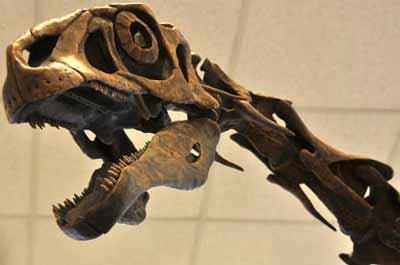Dinosaurs are a subject of fascination for many people of all ages, and a new exhibit, "Mystery of the Sickle-Claw Dinosaur," will be on display at Glen Canyon National Recreation Area for the next year.
Why the name, and what's so mysterious?
According to a park spokesperson, "This 93-million year old plant-eater stood 13 feet tall and weighed about 1 ton. The nickname 'sickle-claw dinosaur' stems from the creature’s unique claws that measure 8 inches in length. The dinosaur likely used these claws to probe for termites as well as defend itself against some of the ferocious meat eaters it encountered on land. During the late Cretaceous Period when this dinosaur roamed the earth, Glen Canyon and the surrounding area was covered by the Cretaceous Western Interior Seaway."
"The 'mystery' of this amazing land dinosaur is that the remains were found buried deep in a layer of Tropic Shale, 60 miles from the seashore. You can learn more about how a land-living dinosaur ended up in an ancient seaway at the exhibit."
The exhibit featuring a Therizinosaur "was designed by Museum of Northern Arizona paleontologist Dr. David Gillette and artist Victor Leshyk. A grand opening ceremony on April 13 also unveiled outdoor sculptures of a metal Pteranodon (ancient flying reptile) and Ichythornis (ancient toothed bird) as well as an ingenious robotic plesiosaur, all created by artists Brian and Eric Gold."
"Plesiosaurs were ambush predators that terrorized the Cretaceous seas. The robotic plesiosaur demonstrates the swift swimming movement of these aquatic reptiles. Real plesiosaur bones and teeth that were excavated in the park from the same Tropic Shale rock layer as the therizinosaur are also on display."
Superintendent Todd Brindle acknowledges "the remarkable partnership that had to take place in order to make the exhibit successful."
“This is an excellent example of what can be accomplished when everyone works together to bring an exhibit of this quality to our community,” he said. He also noted that planning an exhibit of this magnitude usually takes a year or two to come together. “Through our remarkable partners,” he added, “we were able to accomplish this in just over two months.”
Along with the National Park Service and the Bureau of Reclamation, major partners in obtaining and installing the exhibit were the Glen Canyon Natural History Association, Museum of Northern Arizona, Navajo Generating Station, Page Steel, and the Glen Canyon Lecture Series.
The exhibit will be on display for one year at the Carl Hayden Visitor Center, located on Highway 89 on west side of Glen Canyon Dam in Page, Arizona. It is free to the public. More information about the exhibit, including how to schedule a visit by a school group, is available at this link.




Add comment